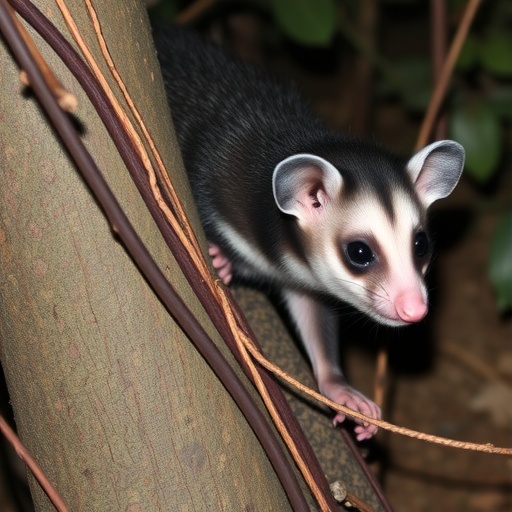In a groundbreaking study, researchers have turned their focus on the environmental impacts of microplastics, particularly on wildlife. The prominent research conducted by Gauto de Melo, Herrera, and Rodrigues critically investigates the presence of microplastics in the bodies of free-living white-eared opossums, scientifically known as Didelphis albiventris, residing in Campo Grande, Mato Grosso do Sul, Brazil. This research sheds light on the untold environmental dangers posed by microplastics and underscores the urgent need for action to mitigate their spread in our ecosystems.
The overwhelming proliferation of microplastics in various ecosystems has become a significant concern for environmental scientists and conservationists globally. Microplastics are minute plastic particles, often less than five millimeters in size, derived from the degradation of larger plastic items or manufactured at that size for various products. Their ubiquity in terrestrial and aquatic environments has entered the food chains of various species, raising alarming questions about their effects on flora and fauna alike.
The biota in urban areas, like the white-eared opossums studied, are particularly vulnerable to microplastic contamination due to their omnivorous diets and their interactions with diverse habitats. Opossums, being opportunistic feeders, consume a wide range of organic materials, which potentially includes contaminated prey or plant matter. The findings from this study provide a pivotal understanding of how microplastics infiltrate food webs at different trophic levels.
The researchers meticulously collected samples from various habitats within Campo Grande, scrutinizing the opossums’ dietary habits and the potential sources of microplastic contamination. The study emphasizes that urbanization and industrial activities lead to increased plastic use and improper disposal methods, fostering an environment ripe for microplastic pollution. The researchers utilized advanced analysis techniques to quantify the levels and types of microplastics present in opossum tissues, revealing shocking results.
In particular, the alarming discovery of microplastic ingestion in these opossums raises questions regarding the overall health of wildlife affected by urban plastic pollution. The rodents often serve as bioindicators, reflecting the environmental conditions of their surroundings. The presence of microplastics in their systems may alter their metabolic processes, impact reproductive health and longevity, and disrupt ecological balance.
Further investigation demonstrated the types of microplastics commonly found within the opossum samples. The researchers identified various polymers, including polypropylene and polyethylene, which are prevalent in consumer products. These microplastics have the potential to leach chemical additives into the tissues of the animals, subsequently entering the food web and posing risks to other species, including humans.
The repercussions of microplastic contamination extend beyond individual species and into broader ecological impacts. The balance of local ecosystems is at risk as microplastic exposure can drastically alter species interactions and environmental processes. This study emphasizes the pressing need for integrated conservation strategies that focus on waste management, pollution reduction, and public awareness to curtail the influx of plastics into ecosystems.
As the world grapples with an escalating plastic crisis, the findings of this research serve as a clarion call for immediate action. The researchers advocate for robust policies aimed at plastic reduction and a shift towards sustainable alternatives in consumer habits. Additionally, educational initiatives that inform communities about the consequences of plastic waste are crucial for fostering stewardship over the environment.
The potential health hazards of microplastics are not limited to wildlife; they extend to human populations. Through the consumption of contaminated organisms and exposure to environmental microplastics, the societal implications are profound. The cross-species transmission of microplastics necessitates rigorous research and public health policies to safeguard ecosystems and human health alike.
In conclusion, the study on microplastics in Didelphis albiventris provides pivotal insights into the pervasive nature of plastic pollution. It underscores how crucial it is to address this environmental issue at both the policy and community levels. As our planet continues to face the consequences of plastic waste, the research opens the dialogue for solutions and highlights the indispensable role of science in addressing ecological crises. Communities must resonate with the dire nature of this issue, uniting to advocate for meaningful change.
In light of this pressing issue, continuous monitoring and empirical research must be conducted to further elucidate the long-term effects of microplastics on various species and their habitats. The findings of this research should stimulate policy changes, conservation efforts, and educational outreach initiatives aimed at curbing plastic pollution and protecting our planet’s biodiversity.
The path forward is clear—innovation, regulation, and community action must converge to address the microplastic crisis. The potential for positive change resides in collective efforts to enhance the health of ecosystems and mitigate the risks posed by microplastics not only to wildlife but to humanity as a whole.
Subject of Research: Microplastic contamination in wildlife
Article Title: Contamination by microplastics in free-living white-eared opossums (Didelphis albiventris) resident in Campo Grande, Mato Grosso do Sul, Brazil
Article References: Gauto de Melo, F.M., Herrera, H.M., Rodrigues, A.C. et al. Contamination by microplastics in free-living white-eared opossums (Didelphis albiventris) resident in Campo Grande, Mato Grosso do Sul, Brazil. Environ Monit Assess 197, 1232 (2025). https://doi.org/10.1007/s10661-025-14682-3
Image Credits: AI Generated
DOI: 10.1007/s10661-025-14682-3
Keywords: microplastics, wildlife, environmental pollution, Didelphis albiventris, ecological health, conservation.




